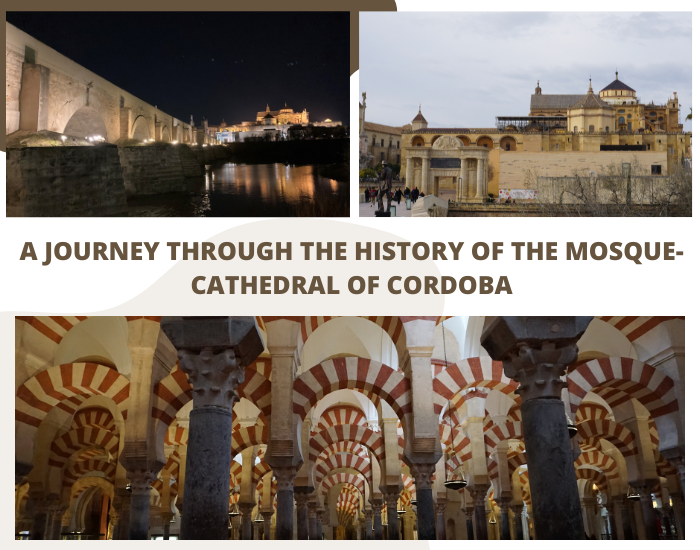

Buenos días amigos,
La semana pasada estuve durante un par de días en la ciudad de Córdoba por motivos laborales. La historia de esta ciudad se remonta desde la época romana, pasando por un largo periodo bajo influencia musulmana y posteriormente tras la reconquista cristiana, a partir a mediados del siglo XIII paso a ser una ciudad cristiana y es por ello que a lo largo de la ciudad podemos encontrarnos multitud de edificios históricos, torres, puentes y palacios que la hacen sin lugar a dudas en uno de los destinos culturales más importantes de España.

Good morning friends,
Last week I spent a couple of days in the city of Cordoba for work reasons. The history of this city goes back to Roman times, passing through a long period under Muslim influence and then after the Christian reconquest, from the mid-13th century it became a Christian city and that is why throughout the city we can find a multitude of historic buildings, towers, bridges and palaces that make it undoubtedly one of the most important cultural destinations in Spain.

Sin embargo, a diferencia de los post de viajes que suelo realizar en los que hago una descripción general de los puntos de interés de la ciudad que he visitado, en esta ocasión debido a la historia, hermosura y el impacto que ha tenido sobre mi descubrir la mezquita-catedral de Córdoba voy a centrarme en este post en este único monumento arquitectónico lleno de historia con una gran hermosura y sobre todo interior.
However, unlike my usual travel posts in which I give a general description of the points of interest of the city I have visited, on this occasion, due to the history, beauty and impact that discovering the Mosque-Cathedral of Cordoba has had on me, I am going to focus in this post on this unique architectural monument full of history with a great beauty and above all interior.

La Mezquita y la noche
El pasado miércoles llegué bien entrada la tarde a Córdoba cuando ya había anochecido, pero aun así, tras atravesar todo el casco histórico de Córdoba, llegue hasta donde se encuentra ubicada la mezquita-catedral a través de la calle Judería, de forma que me encontré de frente con una gran torre llamada Torre del campanario. Como es lógico pensar, este campanario no estaba en la mezquita original, ya que esta torre se integró sobre un antiguo alminar que había en la mezquita musulmana, añadiéndose el cuerpo de campanas.
The Mosque and the night
Last Wednesday I arrived in Cordoba late in the afternoon when it was already dark, but even so, after crossing the entire historic centre of Cordoba, I arrived at the site of the Mosque-Cathedral through Juderia Street, where I came face to face with a large tower called the Bell Tower. As is logical to think, this bell tower was not in the original mosque, since this tower was built on top of an old minaret that was in the Muslim mosque, and the belfry was added.

A continuación, continué mi camino rodeando la mezquita-catedral y en el mismo lado que se encuentra la torre del campanario, pero al otro extremo de la edificación me encontré con una especie de altar donde había una imagen de la Virgen María donde un letrero indica "Si quieres que tu dolor se convierta en alegría, no pasarás pecador sin alabar a María"
I then continued on my way around the mosque-cathedral and on the same side as the bell tower, but at the other end of the building I came across a kind of altar where there was an image of the Virgin Mary with a sign saying "If you want your pain to turn into joy, you will not pass sinner without praising Mary".

Tras estar un momento alabando a María, como indica el cartel, continúe mi camino girando a la izquierda para recorrer todo el lateral de la mezquita. Debido a que ya eran cerca de las 20 h, la puerta principal que da acceso al patio de los naranjos ya estaba cerrada, de forma que seguí caminando hasta que vi que una de las múltiples puertas laterales de la mezquita tenía algo especial. En concreto, esta puerta con un colorido especial es la denominada puerta de San Jose, la cual al igual que su puerta contigua está totalmente restaurada, dándole un extra de color a esta puerta de acceso a la mezquita-catedral.
After a moment of praising Mary, as indicated on the sign, I continued on my way, turning left to walk around the side of the mosque. Since it was already close to 8 pm, the main door leading to the courtyard of orange trees was already closed, so I kept walking until I saw that one of the many side doors of the mosque had something special. Specifically, this door with a special colour is called the door of San Jose, which like its adjoining door has been completely restored, giving an extra colour to this access door to the mosque-cathedral.
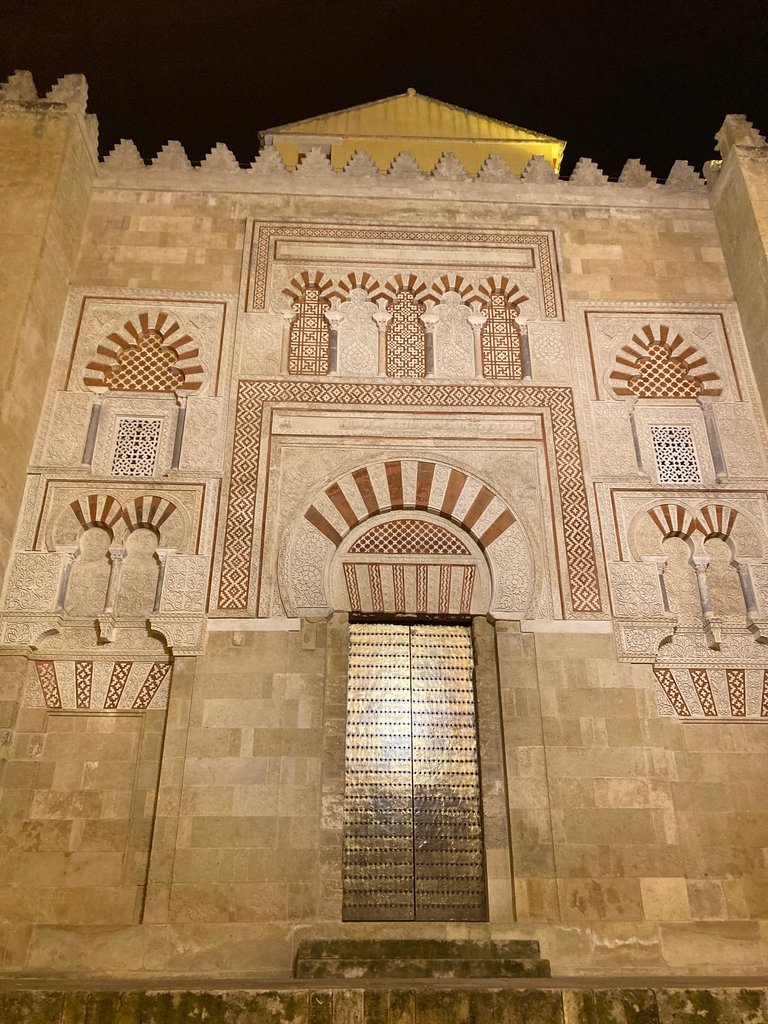

Posteriormente, una vez recorrí todo este lateral de la mezquita, gire de nuevo hacia la izquierda y tras caminar unos metros me encontré con un monumento externo a la mezquita que me llamo la atención que se trataba de la puerta del puente que da acceso al puente romano que recorrí dando un paseo para realizar unas fotos generales de este puente con la mezquita-catedral de fondo reflejada en el agua del río Guadalquivir que atraviesa la ciudad.
Afterwards, once I had walked around this side of the mosque, I turned left again and after walking a few metres I came across a monument outside the mosque that caught my attention. It was the gateway to the bridge that leads to the Roman bridge, which I walked around to take some general photos of this bridge with the mosque-cathedral in the background reflected in the water of the river Guadalquivir that crosses the city.


Satisfecho por lo que había visto e intrigado por descubrir el interior de la mezquita-catedral, me dirigí de nuevo hasta la inmediación del edificio y encontré una pequeña oficina de turismo donde mi informe de los horarios y el tipo de entradas y el coste de las mismas y me emplace a volver al día siguiente después de trabajar.
Satisfied with what I had seen and intrigued to discover the interior of the mosque-cathedral, I went back to the immediate vicinity of the building and found a small tourist office where I was informed of the opening hours and the type and cost of tickets and I set off to return the next day after work.

Pero antes de volver al hotel, descansar para el duro día de trabajo y con la mente puesta en la visita a la mezquita-catedral, me detuve en uno de los múltiples restaurantes que hay en el barrio de la judería del centro histórico de Córdoba, donde disfrute de un excelente salmorejo (sopa fría de tomate, aceite, pan, jamón y huevo) que es un plato típico de esta ciudad y de unos calamares a la andaluza todo ello en un salón espectacular con decorado flamenco y donde había dentro del mismo un limonero ambientando los típicos jardines cordobeses.
But before returning to the hotel, resting for the hard day's work and with my mind set on the visit to the mosque-cathedral, I stopped at one of the many restaurants in the Jewish quarter of the historic centre of Cordoba, where I enjoyed an excellent salmorejo (cold tomato soup, oil, bread, ham and egg) which is a typical dish of this city and some squid Andalusian style, all in a spectacular room with flamenco decorations and where there was a lemon tree inside the room with the typical Cordovan gardens.

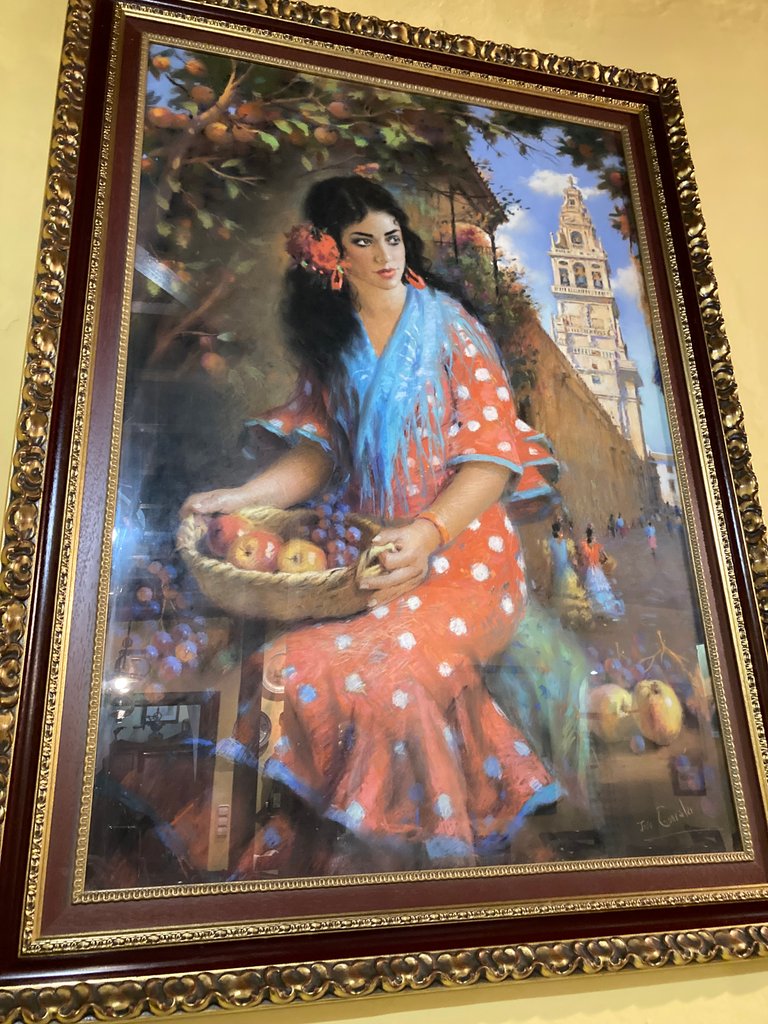
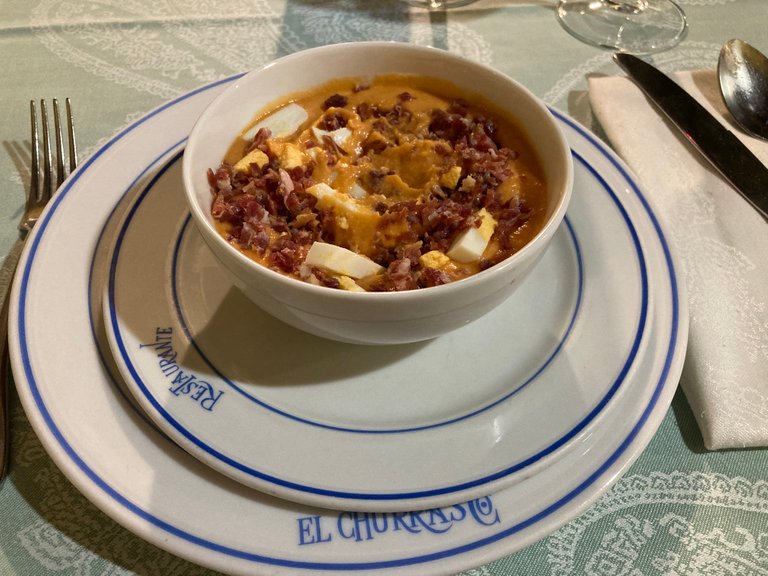

Descubriendo el interior del templo
Al día siguiente, tras salir del trabajo, dejé mis pertenencias en el hotel y tras recoger mi cámara de fotos me dirigí a la mezquita-catedral sin detenerme en ningún momento, ya que sólo disponía de una hora para visitarla. Para acceder a este gran monumento me dirigí a la puerta de Santa Catalina, que es la vía de acceso a este lugar.
Discovering the interior of the temple
The next day, after leaving work, I left my belongings at the hotel and after picking up my camera I went to the mosque-cathedral without stopping at any time, as I only had an hour to visit it. To access this great monument I went to the Santa Catalina gate, which is the access route to this place.

Una vez que atravesé esta puerta, a diferencia de otras catedrales donde ya entras en el propio edificio, lo primero que te encuentras es un gran y bonito patio llenos de árboles y algunas fuentes. Debido a que son naranjos la mayor parte de los árboles existentes en este lugar, el patio recibe el nombre del Patio de los Naranjos.
Desde este patio uno puede contemplar tanto la Torre del Campanario que el día anterior había visto desde fuera como también la cúpula central de catedral en lo que hace muchos siglos era la gran mezquita del califato de Córdoba..
Once through this door, unlike other cathedrals where you enter the building itself, the first thing you come across is a large and beautiful courtyard full of trees and some fountains. Because most of the trees here are orange trees, the courtyard is called the Patio de los Naranjos (Orange Tree Courtyard).
From this courtyard you can see both the Bell Tower which you had seen from the outside the day before and also the central dome of the cathedral in what many centuries ago was the great mosque of the Caliphate of Cordoba.
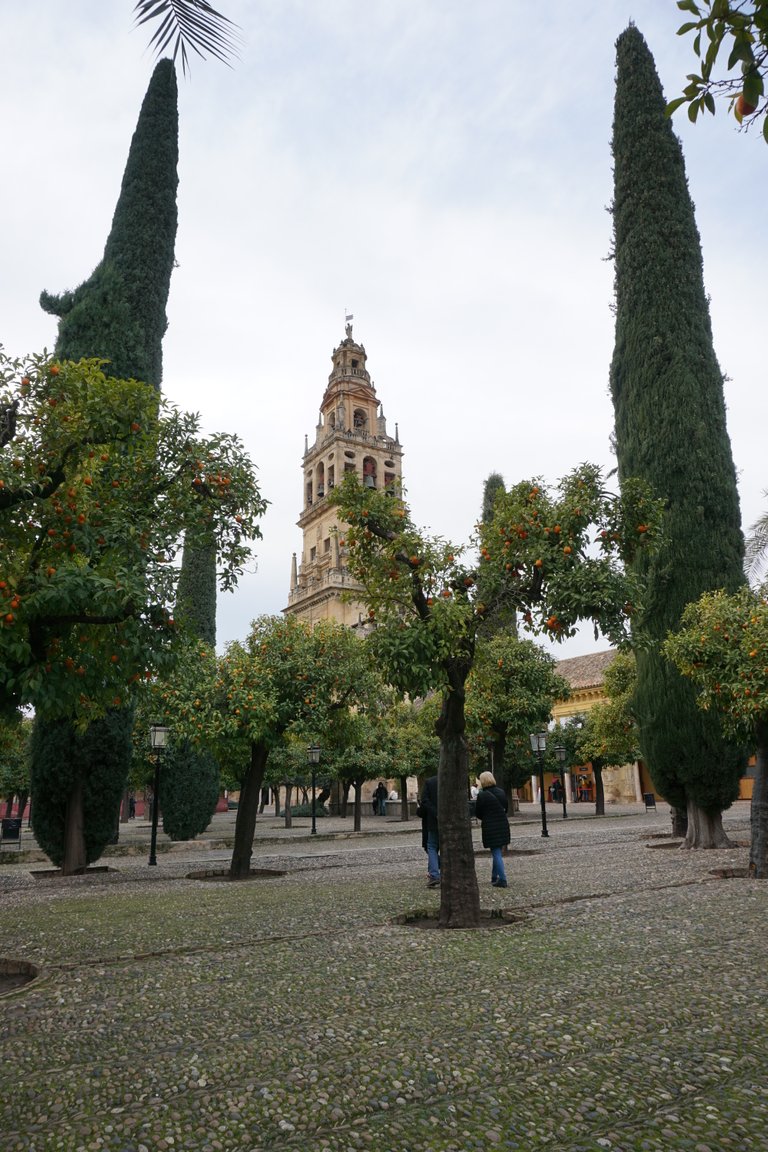
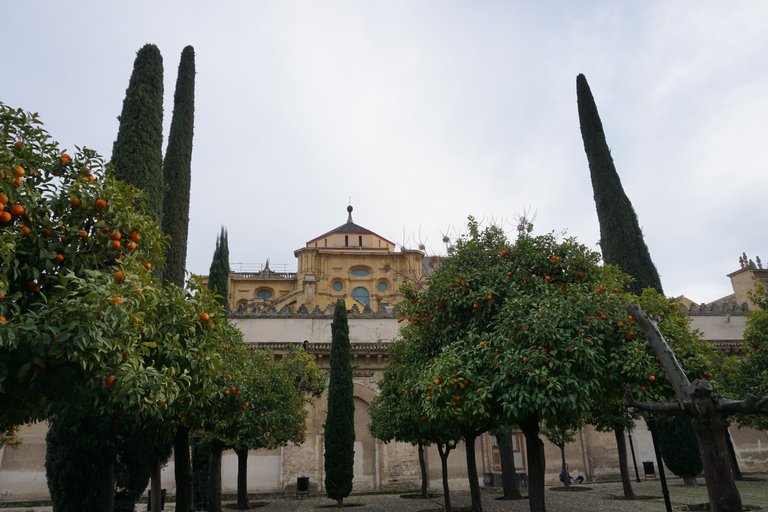
Tras sacar mi entrada en unas taquillas ubicadas en el propio Patio de los Naranjos, accedí al interior de la mezquita catedral, donde tuve acceso a la guía de la que os comparto el link.
Según se detalla en la guía en la última página, en la línea temporal de la construcción de la actual mezquita-catedral, se puede ver que hasta el siglo VIII en este lugar había algunos templos cristianos y la construcción de la mezquita islámica se desarrolló desde finales del siglo VIII hasta mediados del siglo XIII. A su vez, tras la reconquista cristiana de la ciudad en el año 1237, esta mezquita fue poco a poco transformada en un templo cristiano hasta llegar a la actual catedral.
After getting my ticket at the ticket offices located in the Patio de los Naranjos, I entered the interior of the mosque-cathedral, where I had access to the guide of which I share the link with you.
As detailed in the guide on the last page, in the timeline of the construction of the current mosque-cathedral, you can see that until the eighth century in this place there were some Christian temples and the construction of the Islamic mosque was developed from the late eighth century to the mid-thirteenth century. In turn, after the Christian reconquest of the city in 1237, this mosque was gradually transformed into a Christian temple until it became the current cathedral.
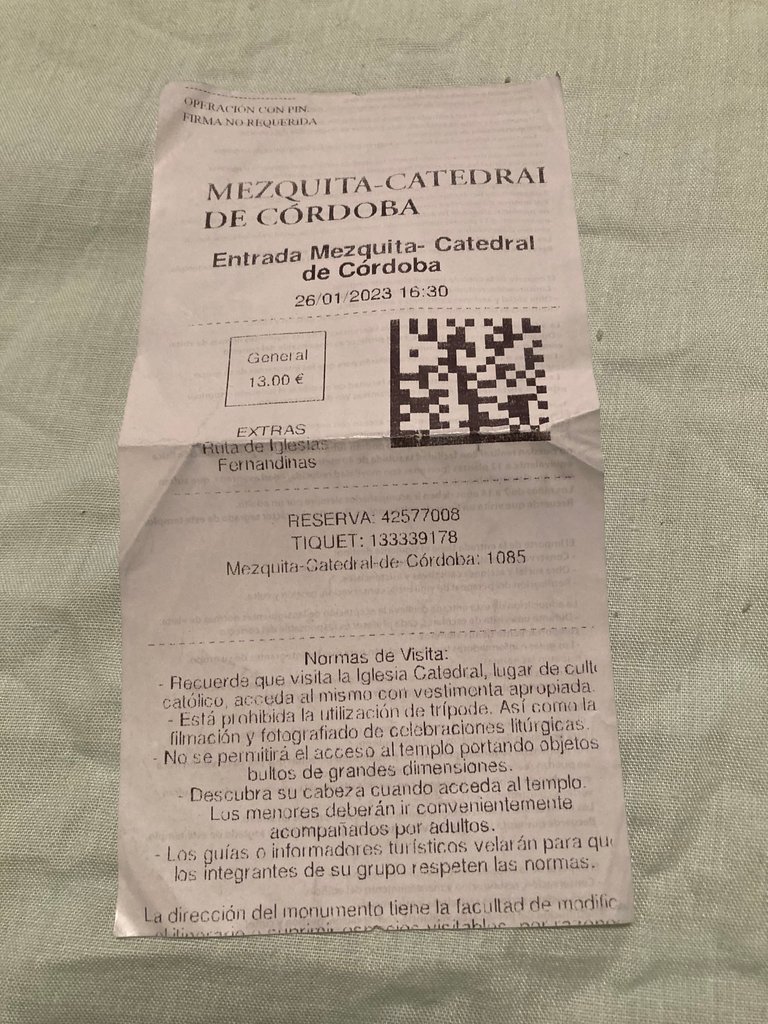
Para acceder al templo se accede por la puerta que da entrada a la mezquita primitiva o mezquita de Abderamán I (príncipe de Omeya y primer emir de independiente de Córdoba). Como se puede ver, la espectacularidad de sus arcos le dan un atractivo impresionante a esta zona originaria de la mezquita.
The entrance to the temple is through the door that leads to the original mosque or mosque of Abderaman I (prince of Umayyad and first independent emir of Cordoba). As can be seen, the spectacular arches give an impressive attraction to this original area of the mosque.
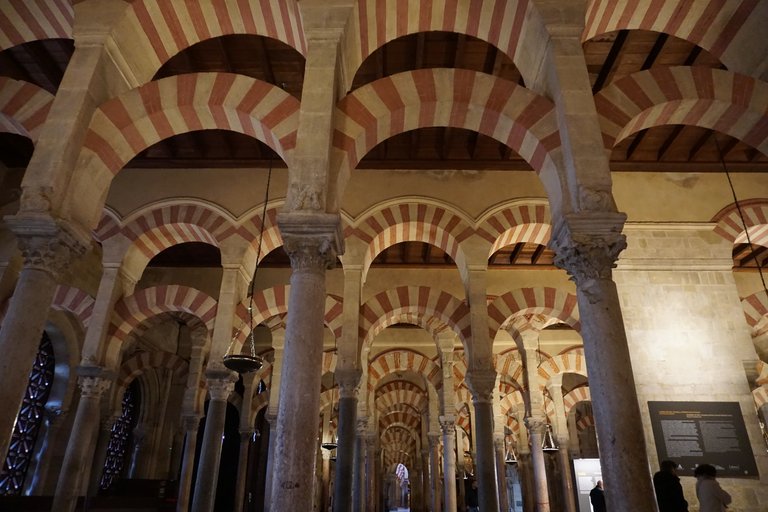
Una información que me pareció muy llamativa de la guía fue que en ella se indica que antes de la construcción de la mezquita de Abderramán en ese mismo lugar habían existido una antigua basílica e incluso durante un tiempo parece que pudo ser dividida su uso entre los dos credos. De hecho, en esta zona de la mezquita existe una exposición de varios objetos encontrados en excavaciones arqueológicas realizadas en el suelo de la mezquita.
One piece of information that I found very striking in the guidebook was that it indicates that before the construction of Abderraman's mosque on the same site there had been an ancient basilica and even for a time it seems that its use may have been divided between the two faiths. In fact, in this area of the mosque there is an exhibition of various objects found in archaeological excavations carried out on the floor of the mosque.
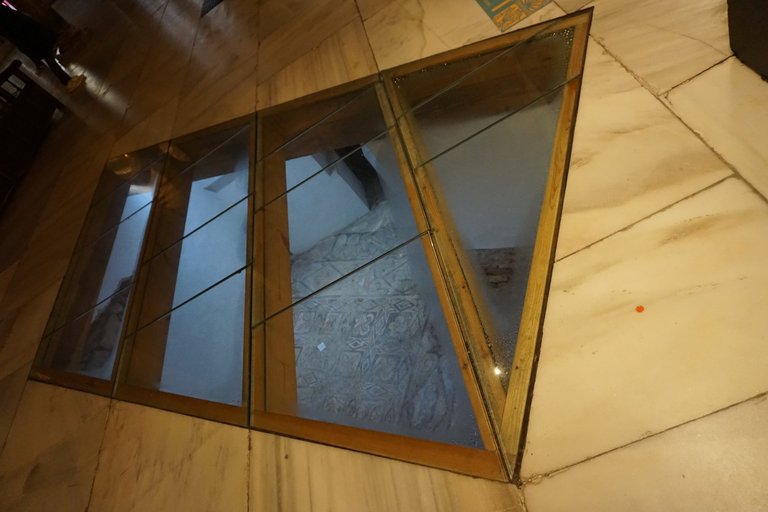
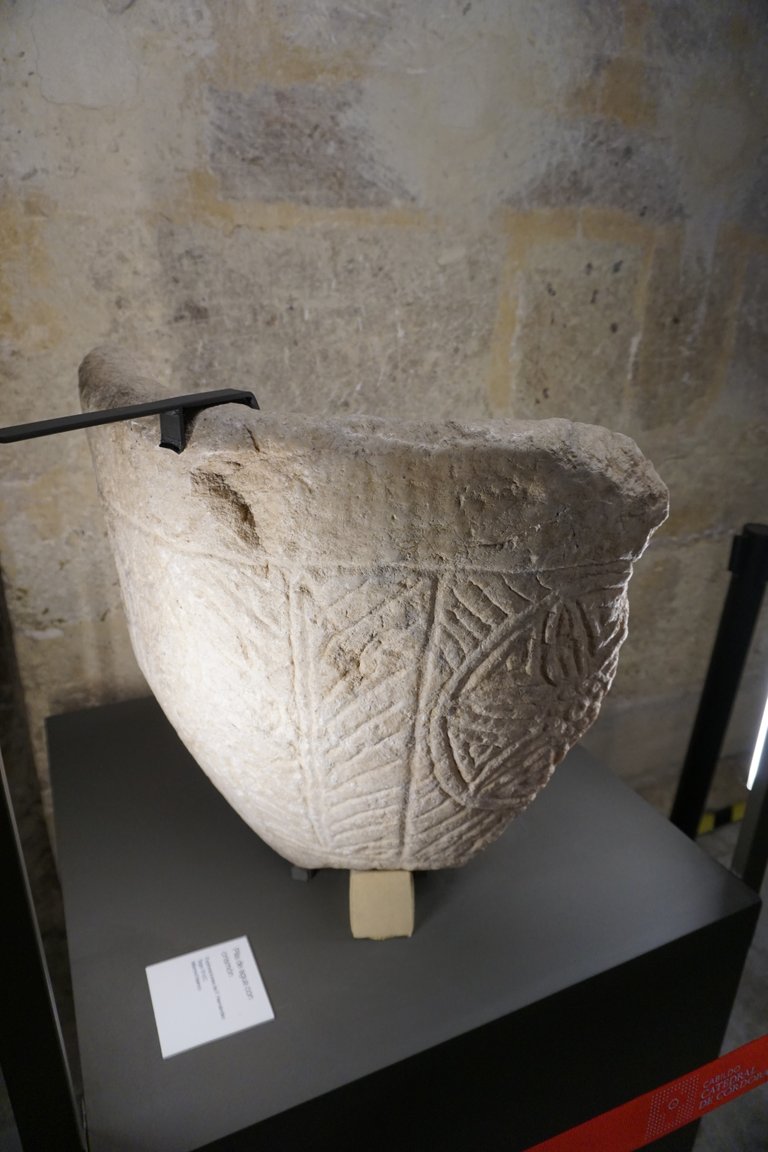
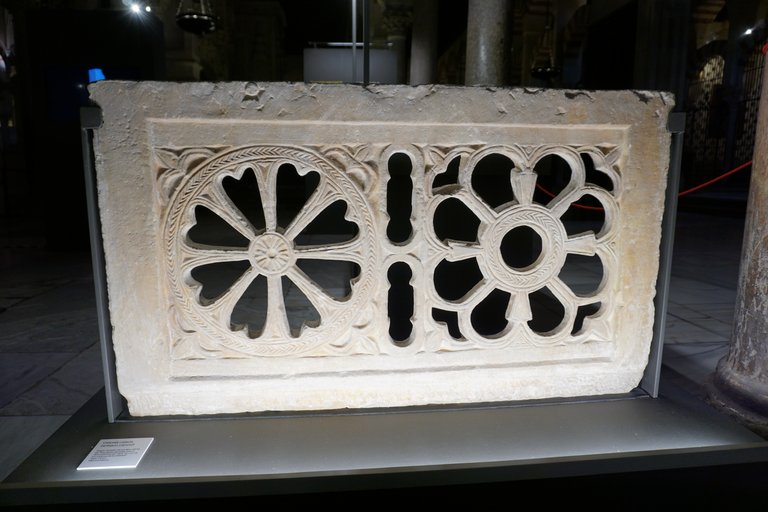

A continuación, una vez vista la exposición en la primera parte de la mezquita, continúe mi camino hacia lo que se denomina ampliación de Abderramán II, que fue una ampliación de la mezquita original. Para aquellos, que les pueda parecer que son los mismos arcos que fueron fotografiados anteriormente, les invito a se fijen en el techo. Como pueden ver hay un cambio en el techo que hay entre los arcos que es una forma sencilla de saber o localizar si estamos en la misma fase de la construcción de la mezquita.
Next, having seen the exhibition in the first part of the mosque, I continued on my way to what is called the Abderraman II extension, which was an enlargement of the original mosque. For those of you, who might think that these are the same arches that were photographed earlier, I invite you to look at the ceiling. As you can see, there is a change in the ceiling between the arches which is a simple way to tell if we are in the same phase of the mosque's construction.
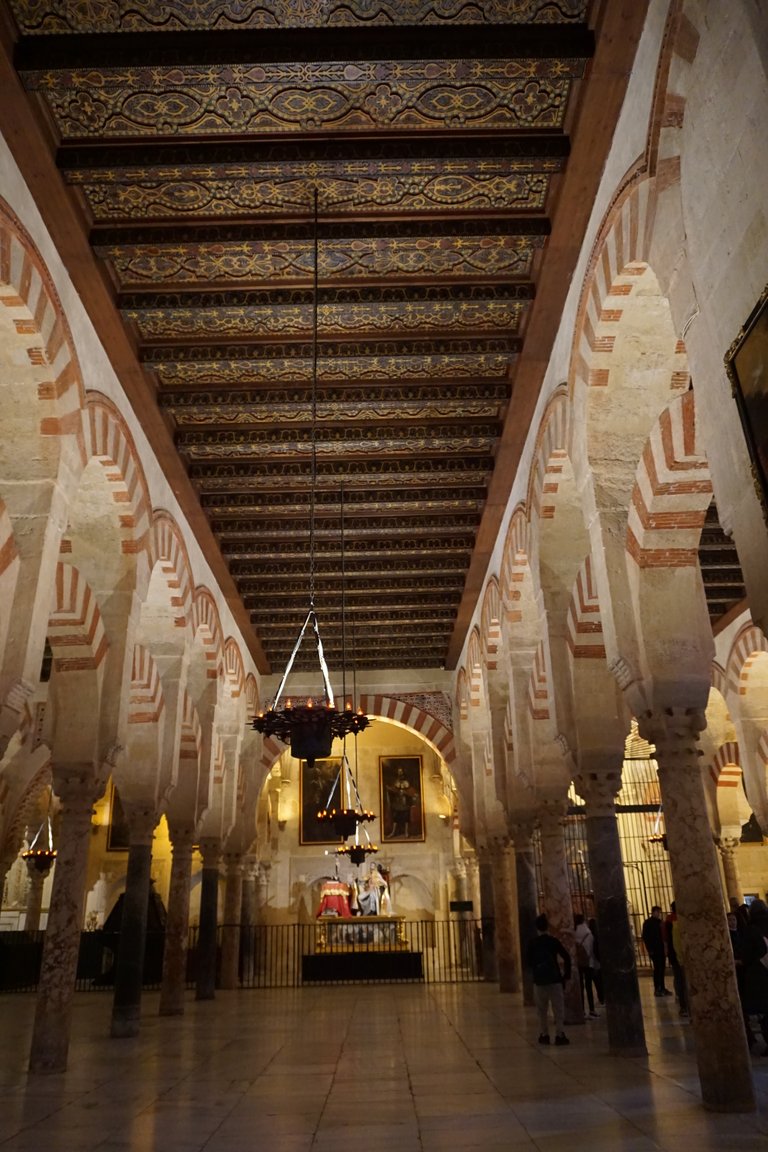
Adicional a los maravillosos e hipnóticos arcos y columnas que forma la mezquita primitiva y la ampliación de Abderramán II en los laterales de la mezquita, nos podemos encontrar con múltiples altares cristinos pertenecientes a múltiples familias. Los cuales, debido a que en su interior hay obras de arte de alto valor, se encuentran protegidas con grandes verjas.
In addition to the marvellous and hypnotic arches and columns that form the primitive mosque and the extension of Abderraman II on the sides of the mosque, we can find multiple Christian altars belonging to multiple families. These are protected by large gates because they contain works of art of great value.
Por otro lado, aunque para ir diferenciando cuando estamos cambiando de ampliación de la mezquita os he recomendado mirar al techo para ver las diferencias, también os animo a vigilar donde ponemos los pies, debido a que como en otras catedrales o basílicas muchas de las personas importantes de la iglesia o de las familias de la nobleza enterraban en las catedrales a sus seres queridos.
On the other hand, although to differentiate when we are changing the extension of the mosque I have recommended you to look at the ceiling to see the differences, I also encourage you to watch where we put our feet, because as in other cathedrals or basilicas many of the important people of the church or of the families of the nobility buried their loved ones in the cathedrals.
Cuando me disponía a dirigirme a la última de las ampliaciones de la mezquita, la denominada ampliación de Alhakén II me llamo la atención unas cuantas habitaciones laterales donde a lo lejos pude ver una especie de gran escultura de oro y plata llamada custodia procesional cuya placa identificadora indicaba que había sido fabricada en los 1510 y 1516.
When I was about to go to the last of the extensions to the mosque, the so-called Al-Haken II extension, my attention was drawn to a few side rooms where in the distance I could see a kind of large gold and silver sculpture called a processional monstrance whose nameplate indicated that it had been made in 1510 and 1516.
Aparte de esta gran joya, otros ornamentos católicos llamaron mi atención, como uno gran crucifijo en oro y plata y una estatua en plata y oro blanco.
Apart from this large jewel, other Catholic ornaments caught my attention, such as a large crucifix in gold and silver and a statue in silver and white gold.
Al salir de estas salas donde multitud de reliquias de oro y plata estaban siendo expuestas, me encontré con otra sala donde se exponían distintos capiteles y me llamo la atención una exposición donde se reflejaban las distintas inscripciones encontradas en las distintas columnas que forman parte de la mezquita. Me asombro el gran número de nombres o firmas de los distintos arquitectos o escultores que fueron trabajando durante el desarrollo de la mezquita.
On leaving these rooms where a multitude of gold and silver relics were being exhibited, I came across another room where different capitals were on display and my attention was drawn to an exhibition of the different inscriptions found on the different columns that form part of the mosque. I was amazed by the large number of names or signatures of the different architects and sculptors who worked on the mosque during its development.
Finalmente, tras visitar estas salas laterales, mi camino continuó por la gran ampliación de Alhakén II y Almanzor. Donde los techos volvían a ser diferentes a los anteriores, también el tipo de columnas y a su vez se podía ver otro tipo de arcos combinados con arcos similares a los vistos anteriormente.
Finally, after visiting these side rooms, my path continued through the great extension of Alhaken II and Almanzor. Where the ceilings were again different from the previous ones, also the type of columns and at the same time we could see another type of arches combined with arches similar to the ones seen before.
Al igual que en las otras partes de la mezquita, en los laterales había múltiples altares. Sin embargo, llamo mi atención que en muchos de ellos se había incluido gravados en piedra en los arcos originales.
As in the other parts of the mosque, there were multiple altars on the sides of the mosque. However, I was struck by the fact that many of them included stone carvings on the original arches.
Por último, el final de mi visita dentro de la mezquita- catedral fue visitar la capilla mayor y el coro. Es la parte central de la mezquita-catedral donde hay una gran bóveda con bonitos retablos y grandes altares donde mis ojos se perdían al no saber donde mirar con la gran belleza del templo.
Finally, the end of my visit inside the mosque-cathedral was to visit the main chapel and the choir. It is the central part of the mosque-cathedral where there is a great vault with beautiful altarpieces and large altars where my eyes were lost not knowing where to look with the great beauty of the temple.
Finalmente, tras una hora de recorrido, salí de nuevo al patio de los naranjos y como aún quedaba una hora de sol, aproveche para fotografiar de nuevo la Torre del campanario y aproveche para volver hasta el puente romano y fotografiar una vez más como el día anterior la puerta de San Jose, la puerta de acceso al puente romano y desde el final del puente romano una panorámica general de la mezquita-catedral.
Finally, after an hour's walk, I went back out into the courtyard of the orange trees and, as there was still an hour of sunshine, I took the opportunity to photograph the bell tower once again, and I took the opportunity to go back to the Roman bridge and photograph once again, as on the previous day, the gate of San Jose, the access gate to the Roman bridge and, from the end of the Roman bridge, a general view of the mosque-cathedral.
Espero les haya gustado esta visita a un lugar con tanta historia.
En próximos días y espero que no sean semanas, espero poder escribir sobre la multitud de lugares culturales e históricos de esta maravillosa ciudad que por lo que he visto en el mapa de pinmmaple no ha habido muchos post publicados sobre ella.
Saludos
I hope you enjoyed this visit to a place with so much history.
In the coming days, hopefully not weeks, I hope to be able to write about the many cultural and historical places in this wonderful city which, from what I have seen on the pinmmaple map, there have not been many posts published about it.
Regards


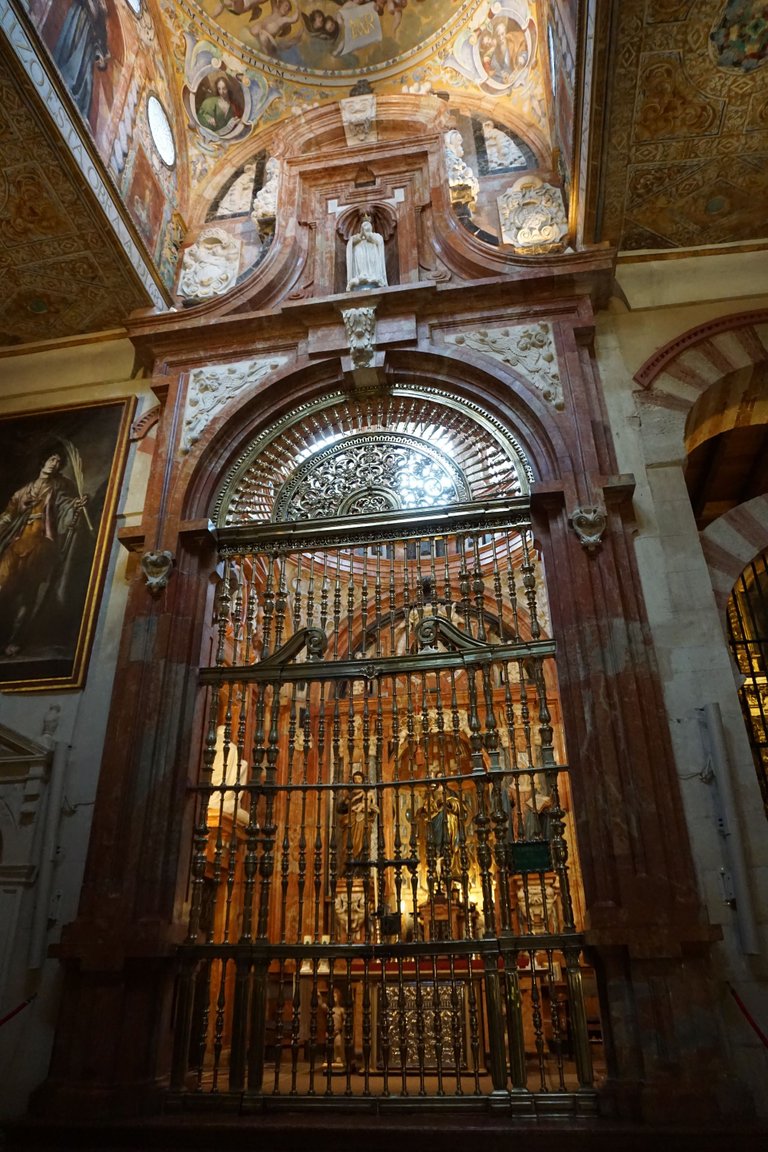
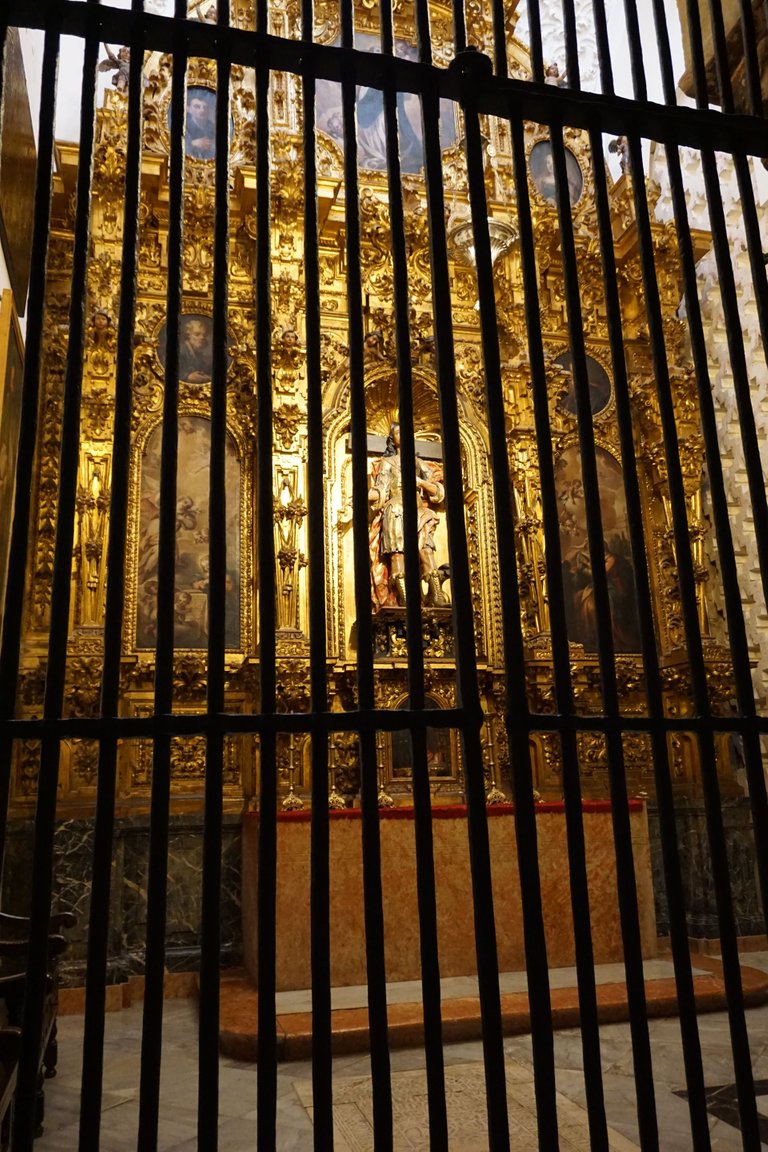
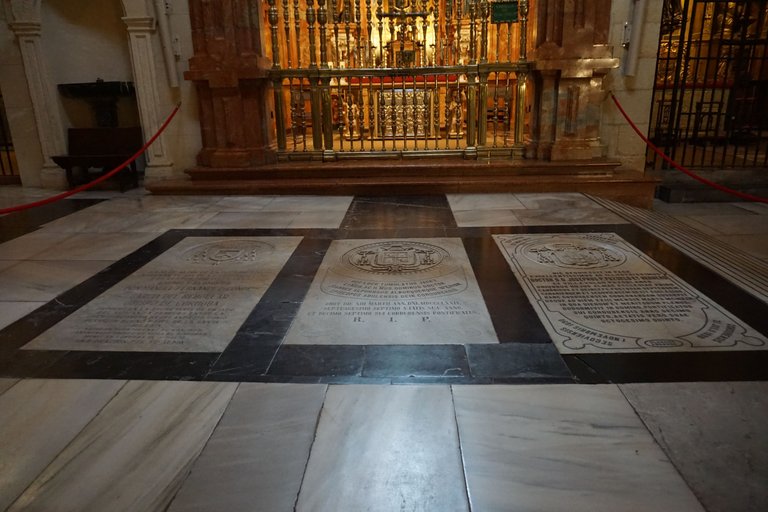
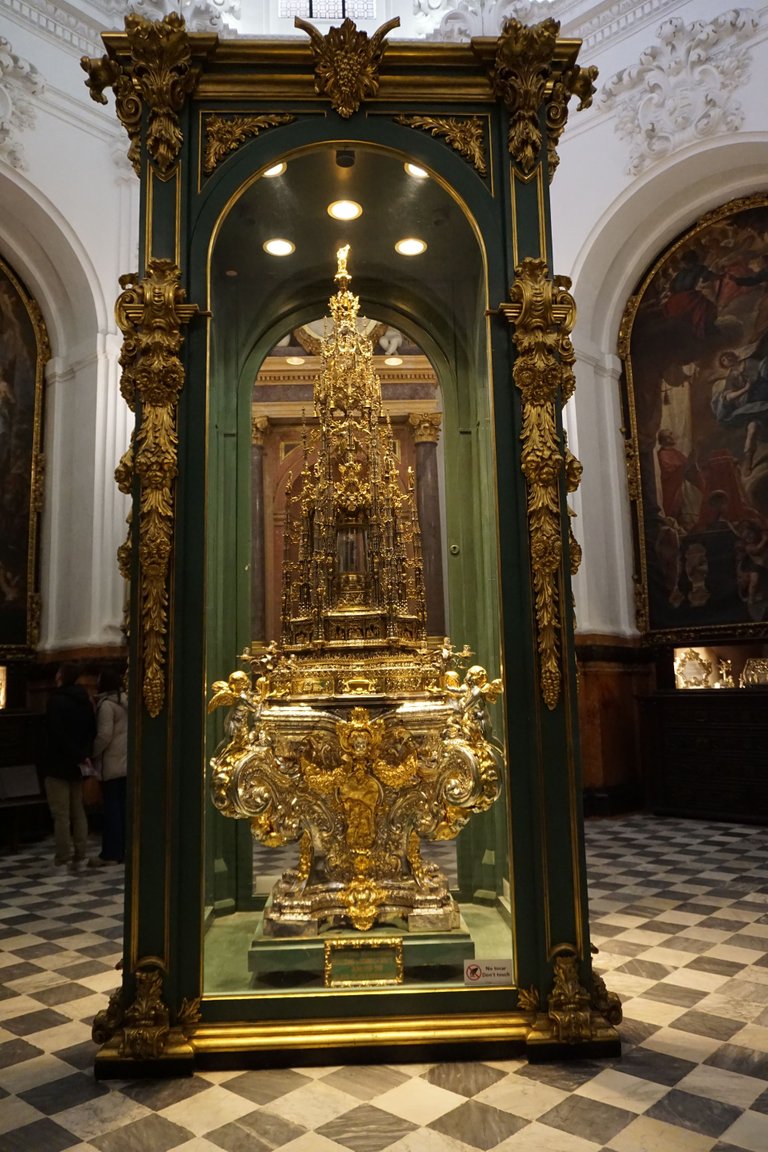
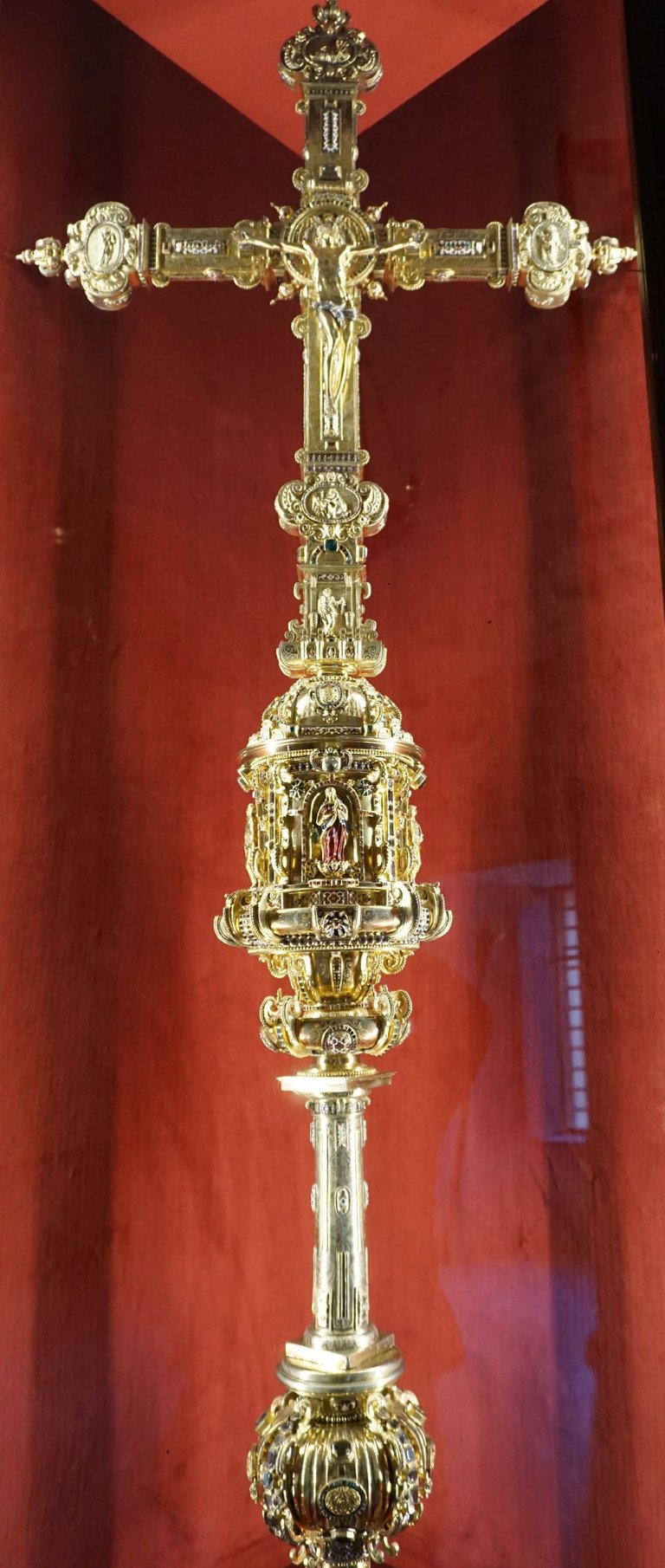
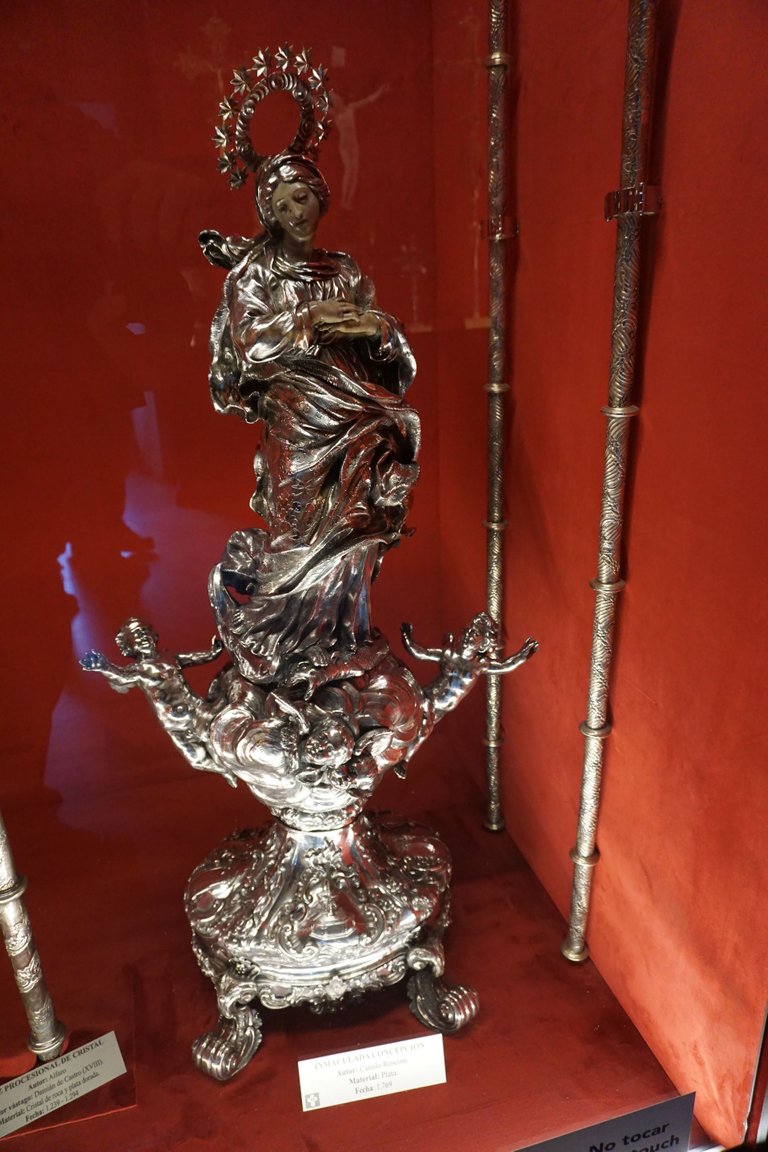

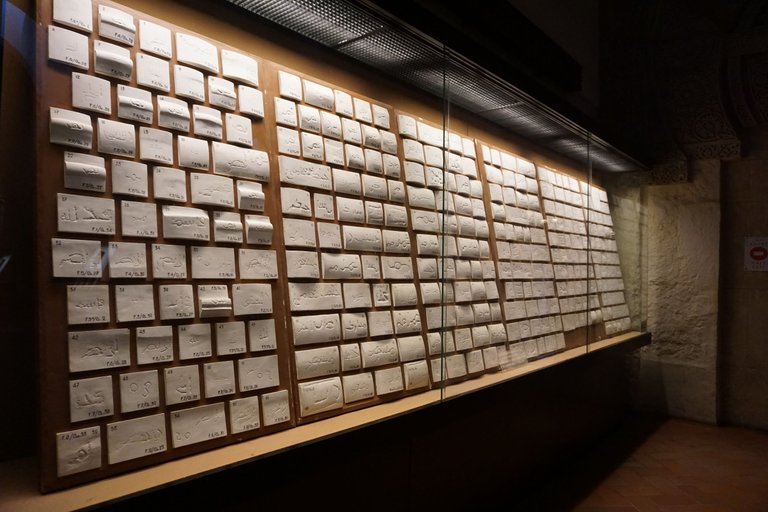
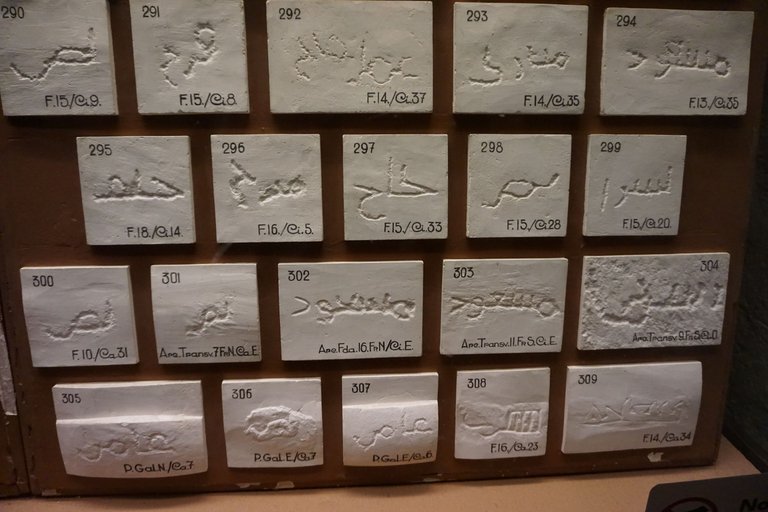
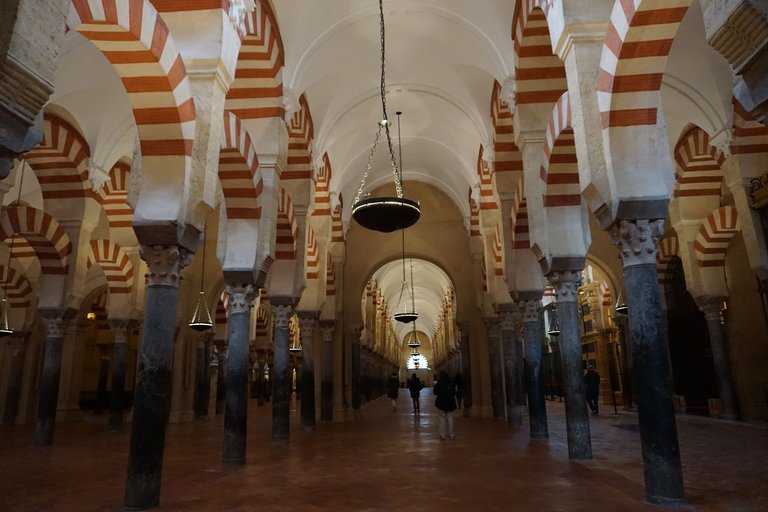
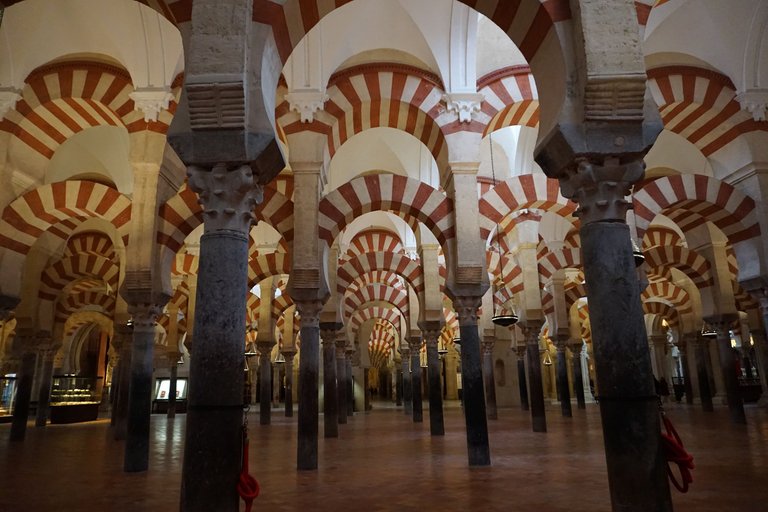


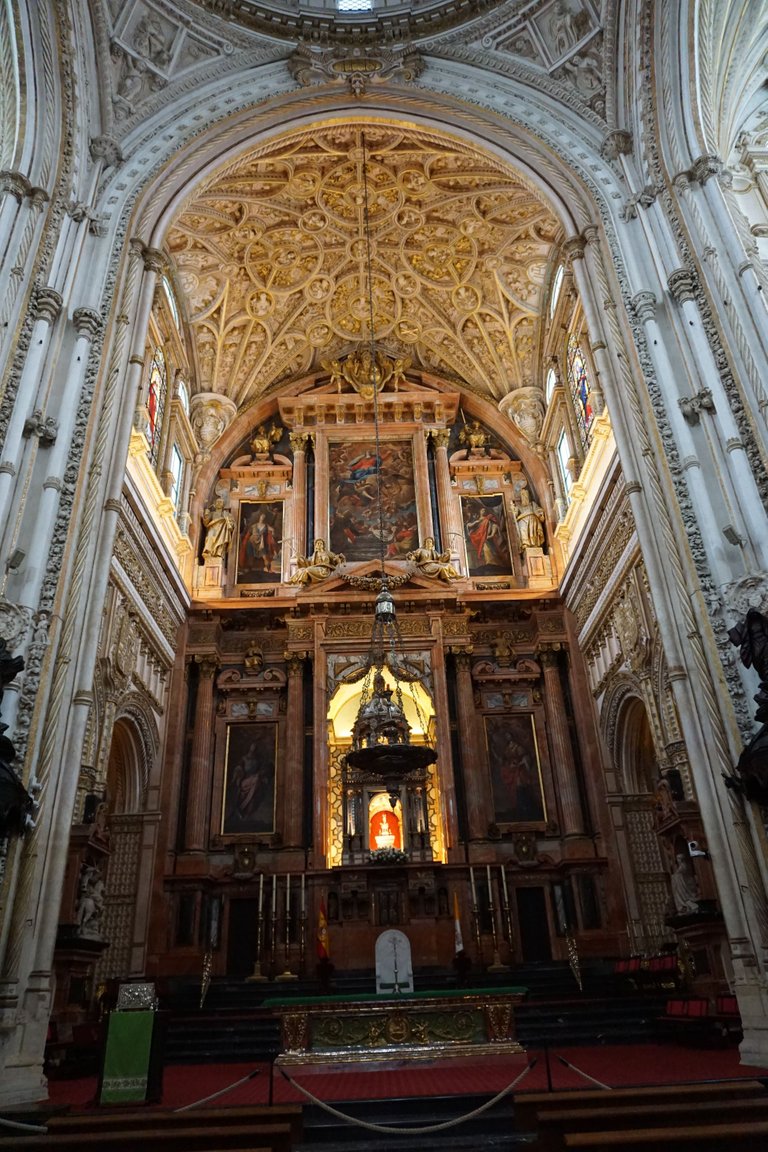
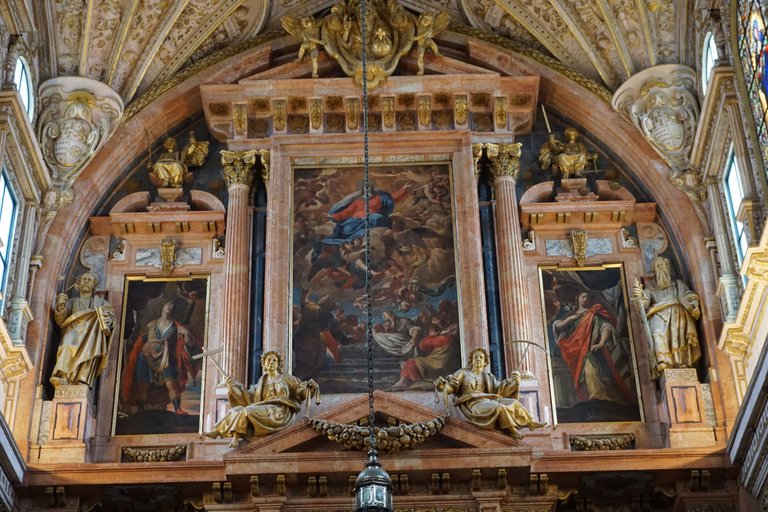
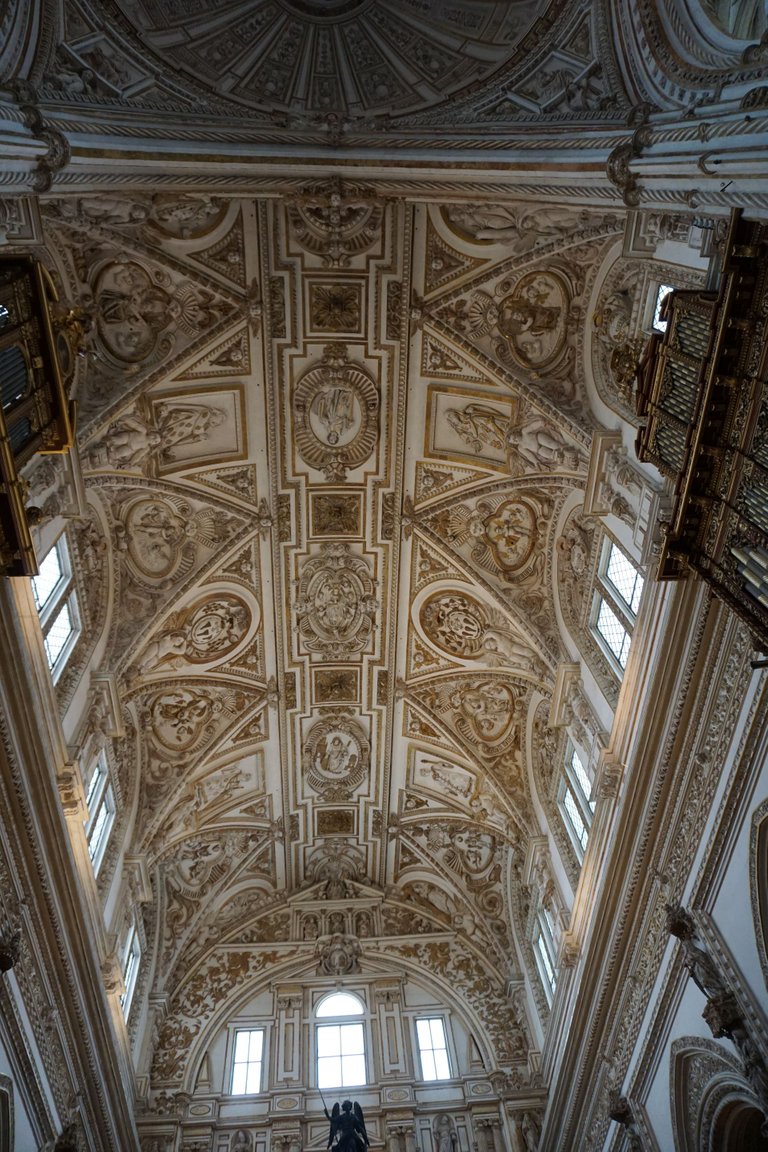
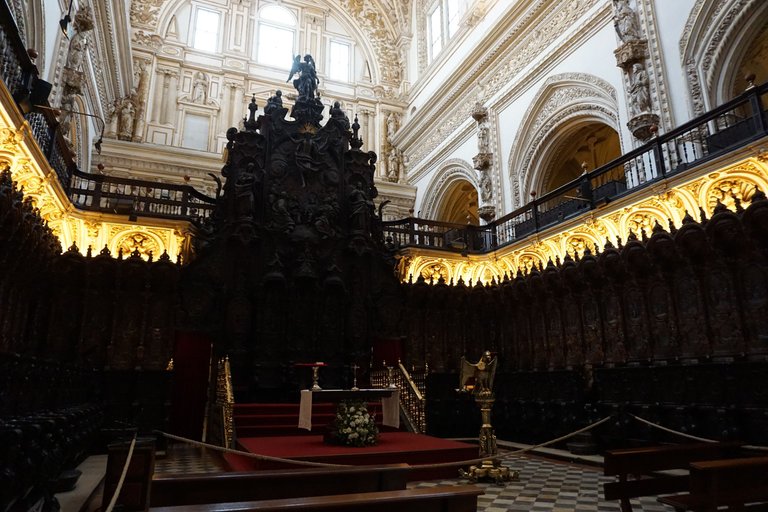


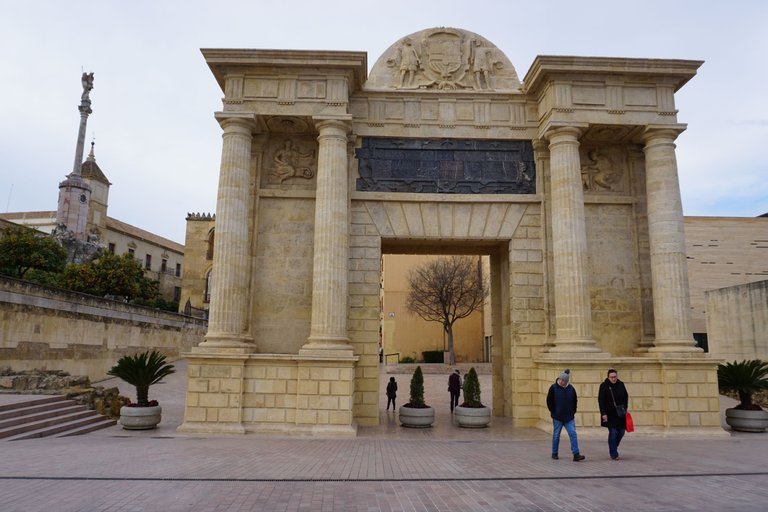
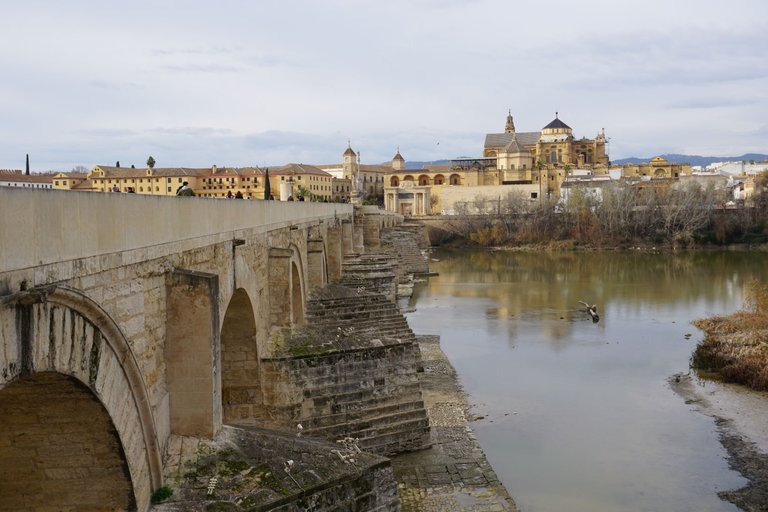

View or trade
BEER.Hey @castri-ja, here is a little bit of
BEERfrom @pixresteemer for you. Enjoy it!Learn how to earn FREE BEER each day by staking your
BEER.Congratulations, your post has been added to Pinmapple! 🎉🥳🍍
Did you know you have your own profile map?
And every post has their own map too!
Want to have your post on the map too?
Me encanta viajar virtualmente por el mundo, en un futuro cercano, podremos oler y hasta saborear, y por qué no, sentir la temperatura de esos lugares lejanos. Gracias por ayudarnos a conocer los parajes que visitas. Un abrazo en la lejanía.
Gracias @amigoponc.
Esta es la primera entrega.
Comentarte que he andado la semana pasada 14km por Córdoba recorriendo torres, mezquitas, alcázares de los reyes cristinos, jardines, patios cordobeses, barrios de la judería, murallas romanas y hasta un templo romano. He quedado impresionado y será posiblemente el post más largo que vaya escribir.
!LUV
Ánimo amigo. Te recuerdo que el máximo de palabras que soporta una publicación son 6000. Yo hice una publicación el año pasado que superó las 7000 y tuve que hacer dos del él para poderlos publicar…
Existe una app 3Speak, en la cual podrá monetizar los videos que pudiera hacer de esos hermosos e interesantes lugares que visita…
Gracias por el recordatorio.
Hace unos meses hice una publicación con cerca de las 6000 palabras y quedo el post a medio publicar
Cuando tenga un poco de tiempo investigare con calma 3Speak y sobre todo mi cámara de fotos el modo de creación de video. Pero el día a día de trabajo, caminatas para buscar nuevos lugares que mostrar y la familia dejan poco tiempo para el aprendizaje de otras apps de Hive.
The rewards earned on this comment will go directly to the people( @castri-ja ) sharing the post on Twitter as long as they are registered with @poshtoken. Sign up at https://hiveposh.com.
Muy interesante historia, la espectacular mezquita.
Me gustan los lugares con historias, quizás no sepa mucho, pero sé que ahí se aprende más.
El patio de los naranjos se ve muy tranquilo como para quedarse un rato relajandose.
Lo malo de esta época del año es que hace un poco de frio en las mañana y las últimas horas de la tarde
La época del año ideal es la primavera. En esa época del año los naranjos están en flor y el entorno de la mezquita las casas tienen multitud de geranios floridos adornando los balcones.
!PIZZA
!ALIVE !CTP !LUV
Has sido curado por @visual.alive, cuenta curadora del token ALIVE del proyecto @visualblock / You have been curated by @visual.alive, curator account of the ALIVE token of the @visualblock project.
Bienvenidas delegaciones / Delegations welcome
Encuentra nuestra comunidad aquí / Find our community here
Trail de Curación / Curation Trail
That's really interesting piece of history. My favorite part is all the nameplayes, what's interesting is that some of these signatures aren't even in Arabic, and it seems there are a lot of workers whose names rhyme with سعد/مسعود (Pronounced "Sa'd and Mas'oud.)"
!PIZZA !LUV !LOLZ
😊😊😊
!ALIVE
Hiya, @lizanomadsoul here, just swinging by to let you know that this post made it into our Top 3 in Daily Travel Digest #1776.
Your post has been manually curated by the @pinmapple team. If you like what we're doing, please drop by to check out all the rest of today's great posts and consider supporting other authors like yourself and us so we can keep the project going!
Become part of our travel community:
Definitly on my bucket list now! Much more history than I was aware of. Beautiful and informative post. Thank you for sharing :)
There is much more history in the city. Let's see how I organise my 8km tour where I found Roman ruins, Muslim temples, palaces from the 13th century, etc.
The mosque is famaous, but all the Roman ruins is unknown to me! Keep us updated when you keep exploring, as it turns out Gordoba has more than at least I expected :)
The Roman temple is next to the town hall. At the same time there is a Roman bridge over the river Guadalquivir next to the mosque.
In the Alcazar de los Reyes Catolicos I photographed some mosaics from the I-III century.
Let's see if this week I can get organised to write this post as I will have to document myself a bit more about these places.
Amazing! Looking forward to your next post. I have been to Spain only once. Only for one week and that was Malaga, but I took the local bus to Granada, as Alhambra has been one of those places I wanted to visit for years. The mosque in Gordoba is another "want to see". I haven't prepared or red anything about this city yet, but from your post I can see it's got a lot to offer. I think I will have to stay several days...
!LOL
lolztoken.com
If you're not there, then I assume you're not a round.
Credit: reddit
@castri-ja, I sent you an $LOLZ on behalf of @happyphoenix
Delegate Hive Tokens to Farm $LOLZ and earn 110% Rewards. Learn more.
(1/4)
Es realmente un lugar histórico muy hermoso. Muy buenas imágenes. Se agradece mucho que compartiera la experiencia.
Gracias por el comentario
!PIZZA